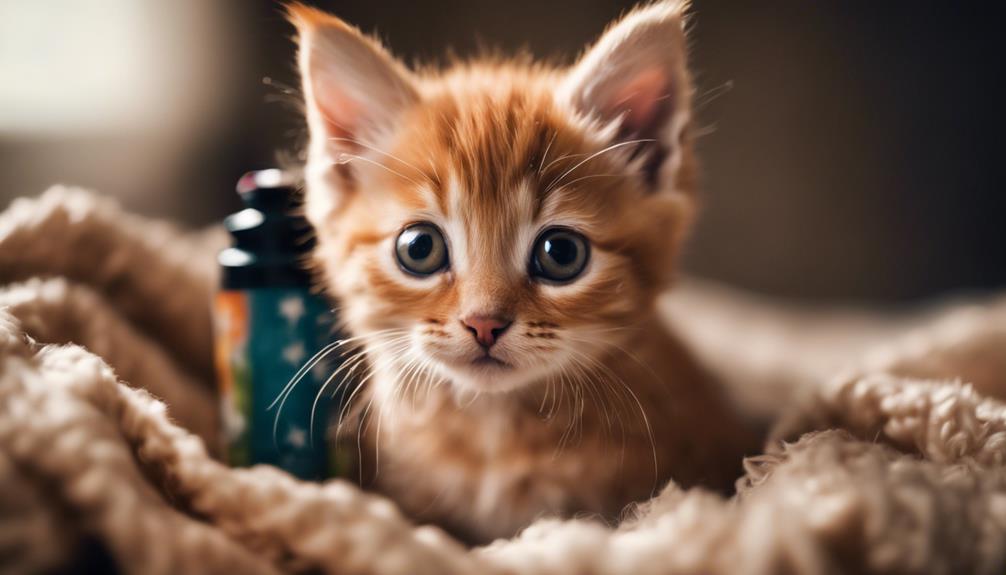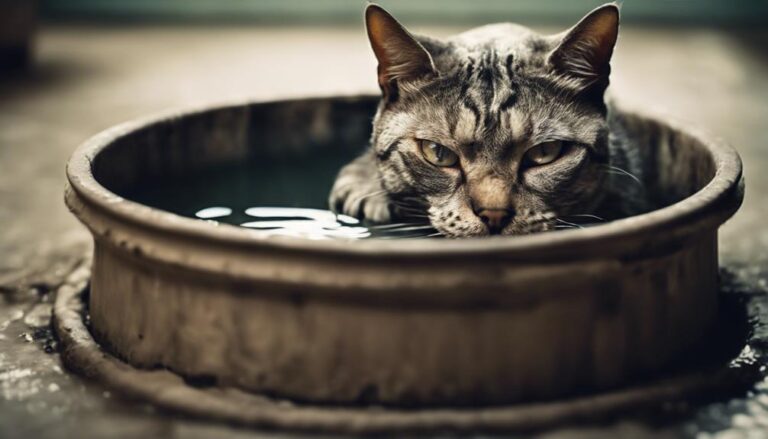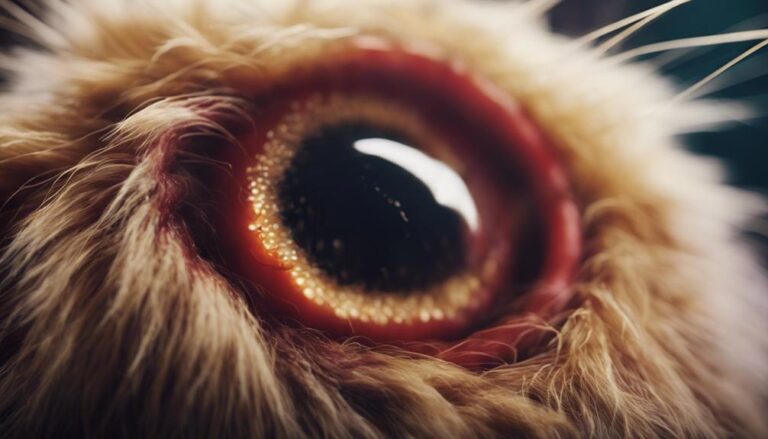When faced with caring for a motherless kitten, your compassion and attentiveness become crucial in providing the nurturing support they need. From creating a safe environment to understanding their nutritional requirements, each step plays a vital role in their development. However, there is one aspect that often goes unnoticed but holds great significance in ensuring the well-being of a motherless kitten. This overlooked element can profoundly impact their growth and overall health, making it imperative to address.
Providing a Nurturing Environment
To create a nurturing environment for motherless kittens, ensure they're kept in a warm, draft-free area with soft bedding to mimic a mother's warmth and comfort. Newborn kittens are particularly vulnerable, so using a heating pad or hot water bottle wrapped in a towel can help regulate their body temperature effectively. This setup replicates the cozy environment a mother cat would provide to keep her kittens warm and secure.
Kittens without a mother need extra care and attention, especially when it comes to feeding. Providing them with a suitable kitten formula is crucial for their growth and development. Additionally, keeping all the kittens together in the same bedding spot offers them a sense of companionship and security, which can help reduce stress and anxiety.
Ensuring Proper Feeding Schedule
Ensure newborn kittens are fed every 2-4 hours using special kitten formula to meet their specific nutritional needs. It's crucial to consult a veterinarian for guidance on the right feeding schedule tailored to your kitten's age and weight.
Monitoring daily weight gain is essential to track their health and development accurately. Avoid feeding them cow's milk as it can lead to digestive issues; stick to the recommended kitten formula. Keeping the formula warm ensures optimal digestion and absorption of nutrients.
If you notice any irregularities in the feeding process or the kitten's behavior, promptly consult veterinary advice. By establishing a consistent feeding routine and following the veterinarian's recommendations, you can help your motherless kittens thrive and grow healthy.
Monitoring Weight Gain and Growth
Regularly weighing your kittens is crucial to track their growth and ensure they're developing properly. Monitoring weight gain is essential in caring for a kitten, as it helps you adjust feeding amounts accordingly to support their healthy development.
Healthy kittens should exhibit steady weight gain, reflecting proper nutrition and care. If you notice sudden weight loss or a lack of weight gain, it could indicate underlying health issues that require attention.
By tracking their progress through regular weigh-ins, you can identify any concerns early on and consult with a veterinarian promptly if needed. Ensuring that your kittens are receiving proper nutrition and gaining weight consistently is key to their overall well-being.
Health Monitoring and Illness Signs
Keep a close eye on your motherless kitten for signs of dehydration, such as dry gums and skin tenting.
Remember to watch out for symptoms of respiratory issues like labored breathing or nasal discharge, which could require immediate veterinary care.
It's crucial to monitor for diarrhea, vomiting, lethargy, weakness, and any other unusual signs that may indicate underlying health problems needing prompt evaluation by a veterinarian.
Symptoms to Watch
When caring for a motherless kitten, it's crucial to closely observe for symptoms that may indicate health issues, such as dehydration, respiratory problems, diarrhea, lethargy, weakness, or weight loss.
Watch out for signs of dehydration like sunken eyes or dry mouth, which can signal a lack of fluids. Monitor for respiratory issues such as coughing, sneezing, or difficulty breathing, as these may point to underlying problems.
Check for diarrhea, which could indicate digestive issues or infections. Keep an eye on lethargy or weakness, as they might be signs of health issues. Additionally, be alert for weight loss or failure to thrive, as these could suggest inadequate nutrition or health problems.
Vet Check-Up Schedule
As you observe symptoms in a motherless kitten, it's important to establish a vet check-up schedule for monitoring their health and detecting any signs of illness promptly.
Schedule a vet check-up within the first week of caring for the kitten to assess their overall health. Regular wellness exams are crucial for monitoring the kitten's growth, development, and ensuring they receive necessary vaccinations and preventive care.
Watch for signs of illness like lethargy, refusal to eat, diarrhea, vomiting, or any unusual behavior indicating a health concern. If the kitten shows distress, severe symptoms such as seizures, or any other emergency symptoms, contact the vet immediately.
Keep emergency vet contact information accessible and follow vet instructions for any emergency situations that may arise while caring for the kitten.
Introduction to Solid Food
When introducing solid food to motherless kittens, start by mixing wet kitten food with milk replacer around 3-4 weeks of age. Gradually adjust the amounts of each to transition them smoothly to solids.
Remember to monitor their response to the new diet and consult a vet for guidance on providing the best nutrition for their growth.
Weaning Process Tips
To ease the transition to solid food for motherless kittens, begin introducing a mixture of wet kitten food and milk replacer around 3-4 weeks of age. Gradually decrease the milk replacer while increasing the amount of wet food in their diet.
Make sure to provide fresh water once the kittens start eating solid food. Monitor their response to the new diet closely and adjust feeding amounts accordingly.
It's essential to consult a veterinarian for guidance on transitioning to a complete kitten diet. By following these weaning process tips, you can help the kittens adapt to their new diet and ensure they receive the necessary nutrition for their growth and development.
Transition to Solids
When your motherless kitten reaches around 3-4 weeks of age, it's time to introduce a mixture of wet kitten food and milk replacer into their diet. Begin by offering small amounts of wet food mixed with milk replacer and gradually decrease the milk replacer while increasing the wet food.
Monitor how your kitten responds to the solid food and adjust the feeding amounts accordingly. Once your kitten starts eating solid food, remember to provide access to fresh water.
To ensure a complete kitten diet, consult a veterinarian for guidance on the transition process. By following these steps, you can effectively care for your kitten without a mother during this important transition to solids.
Nutritious Food Choices
Introducing a variety of nutritious food choices is essential during the transition to solid food for motherless kittens. At around 3-4 weeks, start mixing wet kitten food with milk replacer for weaning.
Over time, decrease the milk replacer while increasing the amount of wet food to facilitate the transition to solid food. Once the kittens begin eating solid food, provide access to fresh water to ensure proper hydration.
Monitor their eating habits closely and adjust food amounts accordingly. For optimal nutrition, consult a vet for guidance on transitioning to a complete kitten diet. This step is crucial to ensure the kittens receive the necessary nutrients for their growth and development.
Transition to Complete Kitten Diet
By around 3-4 weeks of age, gradually introduce wet kitten food mixed with milk replacer to facilitate a smooth transition to a complete kitten diet. Start by offering a mixture of wet food and milk replacer, then slowly decrease the amount of milk replacer while increasing the portion of wet food.
Once kittens begin eating solid food, provide fresh water to ensure proper hydration. It's essential to monitor their progress with solid food closely and adjust their diet as needed for optimal nutrition. Consulting a veterinarian for guidance on transitioning kittens to a balanced diet is advisable.
Remember that a gradual transition and monitoring their response are key to a successful switch to a complete kitten diet. This approach will help support their growth and development, ensuring they receive the necessary nutrients for a healthy start in life.
Emergency Care Preparedness
In case of an emergency with your motherless kitten, having quick access to emergency vet contact information is crucial for prompt assistance. Be prepared to provide detailed information about the kitten's symptoms and behavior when contacting the vet.
Follow the vet's instructions carefully in emergency situations to ensure the best outcomes for your kitten. If you notice severe symptoms such as seizures or signs of distress, seek immediate help to address the situation effectively.
It's important to stay calm and focused during emergencies to provide proper care for the kitten without a mother. Remember that quick action and appropriate responses are key when it comes to emergency care for your vulnerable little one.
Frequently Asked Questions
How Do You Take Care of a Kitten Without a Mother?
To take care of a kitten without a mother, provide warmth, consult a vet for feeding advice, monitor health closely, and offer comfort like a mother cat would. Seek prompt veterinary help for any health issues.
Can a Baby Kitten Survive Without Its Mother?
Yes, a baby kitten can survive without its mother with proper care and nutrition. Providing round-the-clock attention, bottle-feeding with suitable formula, and ensuring warmth are crucial. Monitoring health and growth closely is necessary for the kitten's survival.
What to Do With Kittens That Don't Have a Mom?
To care for kittens without a mother, provide round-the-clock care, including feeding, warmth, and grooming. Consult a vet for guidance and monitor their growth closely. Introduce socialization and playtime for proper development and bonding.
What Do You Feed Abandoned Kittens?
To feed abandoned kittens, give them a special kitten formula like KMR every 2-4 hours. Avoid cow's milk, as it can cause tummy troubles. Make sure the formula is warm but not hot. Consult a vet for feeding advice.






